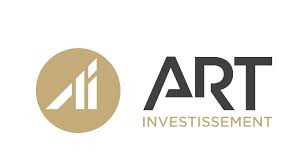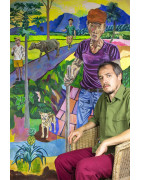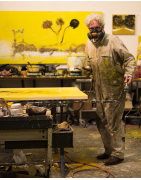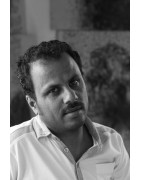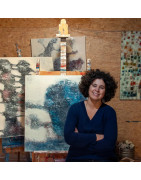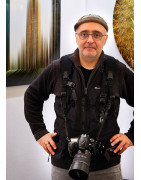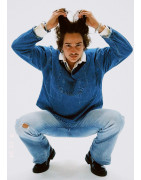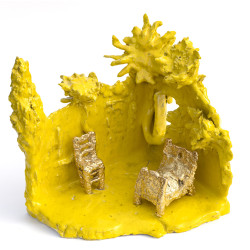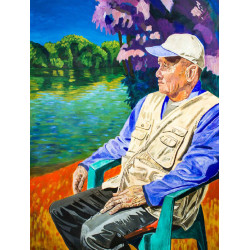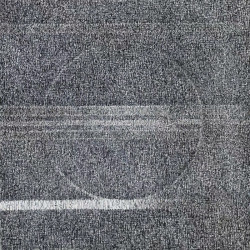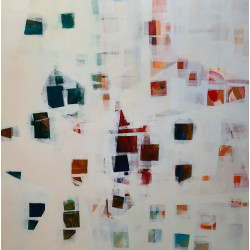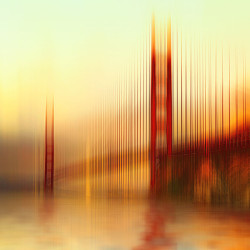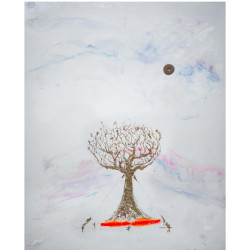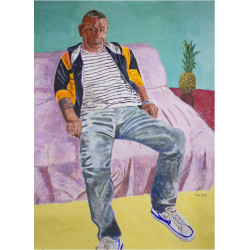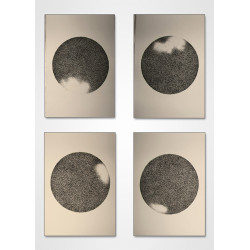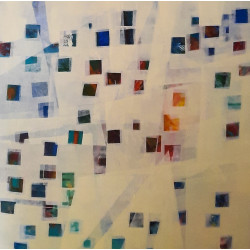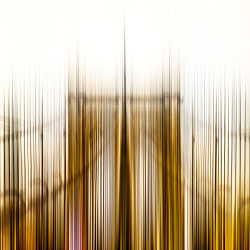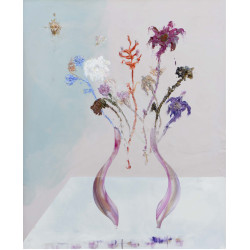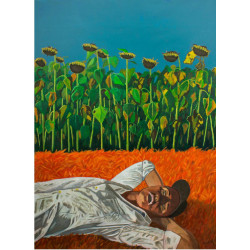Artists
L'artiste a le pouvoir de réveiller la force d'agir qui sommeille dans d'autres âmes.
Friedrich Nietzsche

Subcategories
-
Tom Sam
La peinture de Tom Sam est une exploration intime et sincère de son vécu, de ses souvenirs et de ses rencontres. Inspiré par des photographies qu’il prend la plupart du temps lui-même, Tom peint des proches et des figures familières, cherchant à capturer une vérité émotionnelle mêlant introspection personnelle et confrontation avec le réel. D’un point de départ empathique, il chemine entre l’observation naturelle et intérieure, entre souvenirs et réalités tangibles, entre le ressenti et le perceptible. Ses peintures sont en quelque sorte des enregistrements de cette dualité, dans un souci constant de maintenir en vie une honnêteté vulnérable.
La figure humaine est centrale dans son travail, ce qui peut sembler paradoxal si l’on considère son passé de naturaliste tourné vers la nature sauvage. La peinture alors semble être pour lui une tentative de (ré)conciliation, servant de miroir aux complexités des relations sociales et environnementales. Ses portraits révèlent les tiraillements et les contradictions qui existent entre les mondes d’où nous venons et ceux vers lesquels nous nous dirigeons. Ses œuvres sont peuplées d’individus silencieux, tiraillés entre l’appel du lointain et la recherche de l’amour et de la connexion humaine.
L’artiste croit en une représentation sincère du monde qui l’entoure. Ses personnages et ses scènes sont ancrés dans une réalité tangible, tout en explorant des thèmes tels que la mémoire, l’identité et la condition humaine. Le réalisme qui s’exprime alors ne se dégage pas pour autant d’une forme de romantisme, éprouvé comme une sorte de malédiction qui s’exerce dans le choix des couleurs au contraste violent qui semble contredire le réalisme cruel et rugueux des corps. Les compositions parfois austères laissent transparaître une narration équivoque, une dramaturgie allusive. On ressent alors la difficulté humaine de la fixation, une tension produite par cet équilibre instable entre la vérité menaçante et la beauté rassurante des illusions. -
Valota
Valota is a French artist with Italian origins. He works in his studios in Montreuil-sous-Bois (just outside Paris) and in Normandy.
He works with wax, a unique medium that he masters with fire and fusion. A recent monograph "WAX" published by Editions du Regard, Paris, retraces his singular work.
In 2014, Valota was at La FIAC in Paris showing paintings in wax and pigments from his latest series "Bloom & Vanity" and "Arborescence".
He has showed his work in galleries in Paris, London, and Istanbul, notably alongside Andy Warhol (Fondation Absolut Vodka), Bernar Venet, Bustamente and Frank Stella (Riff Art Projects, Istanbul), Cruz Diez, Vasarely (Lavignes Bastille, Paris)... -
Nasser Al Aswadi
Nasser Al-Aswadi, qui vit depuis 2008 entre Marseille et Sanaa, peint – entre autres – des palimpsestes picturaux. Sur une surface constituée d’une texture de calligraphies faisant le plus souvent référence aux contes et légendes de l’Arabie mythique, il découpe, en petits triangles, des fragments de parchemins où les mots sont devenus des signes visuels. Les assemble et les stratifie en autant de formes centrées : cercle, carré, rectangle, pyramide, etc. « J’emprunte aux parchemins enfouis dans chaque maison, dans chaque porte, dans chaque meuble du Yémen pour les porter vers la lumière et vers l’œil contemporain. » écrit l’artiste. Ses couleurs toujours raffinées font référence aux massifs montagneux de la Hugariyya – où il est né – au sable, au papier, à l’encre indélébile qui ont permis le tracé d’une écriture à la fois ornementale et symbolique. L’œuvre – la toile-parchemin – résiste à l’effacement du temps en captant la matière-lumière de l’immémorial au bénéfice d’une célébration du présent et d’un chant cosmique où la géographie, l’histoire, l’humain, la poésie et le sacré se conjuguent.
-
Hamida Ouassini
Il y a dans le travail d’Hamida Ouassini un questionnement sur la perception d’un monde qui nous met à distance de ce que nous croyons voir. Perception d’une harmonie se dégageant de l’apparente désorganisation de l’ensemble. Perception d’une structure façonnant le chaos.
Et cependant, l’œuvre peinte n’est ici pas plus abstraite que géométrique. Le choix des couleurs, l’agencement des formes, composent des ébauches d’une scénographie que l’œil décode comme autant de traces de vie. Lignes et droites respirent, puis s’assoupissent. Et le spectateur ne peut contenir ce curieux besoin de raconter une histoire.
Aplats soumis à l’usure, vibrance des couleurs et scories de la toile créent un sentiment de nostalgie ouvert à la réflexion sur le travail des formes. Que ne sont-elles portes et fenêtres !
Hommes et femmes aux traits laminés par le soleil ! Doublures de photographies anciennes d’une expédition lointaine ! Complices de joies et de rêves demeurés inassouvis !
-
Bardig
Born in Lebanon in 1963, Bardig is an award-winning artist and photographer based in Paris for over 30 years. He is a graduate of The New York Institute of Photography. After decades of work on the theme of Armenia, and the Armenian genocide, Bardig explores the city with the same sensitivity. It is thanks to the photographic treatment carried out with his softwares that the poetry of photography reveals all its beauty to bewitch us and to draw us into an interior world rich in sensations, showing the limits of the visible and the possibilities to see beyond.
-
Zontone Elliot
Né à Paris en 2002 et ayant grandi à Saint-Émilion, Elliot Zontone est un artiste pluridisciplinaire dont l’univers s’ancre dans la matière, l’instant et l’expérience vécue. Son enfance passée au cœur du vignoble a marqué son regard : la terre, la vigne et le vin sont devenus des métaphores récurrentes dans ses œuvres, tant pour leurs couleurs profondes que pour leur lien à la mémoire et au temps.
Ses toiles, d’influence cubiste et brute, se caractérisent par des gestes larges, des lignes fragmentées, des textures épaisses et des superpositions qui laissent place à l’accident. Elles traduisent une énergie immédiate, où le mouvement, le débordement et la spontanéité priment sur l’intellectualisation. Zontone aime capturer l’intensité d’un instant, la vitalité d’un geste, la densité d’une émotion.
Voyageur infatigable, il nourrit son langage plastique des couleurs vibrantes du Mexique, de la poésie imparfaite de l’Asie, et de la lumière sensuelle du Sud de l’Italie, berceau de ses origines. Le sport, qu’il pratique intensément, influence aussi son travail par le rapport au corps en mouvement, à l’effort, au rythme et à l’endurance. Les rencontres humaines jalonnent son parcours et nourrissent sa peinture d’une dimension intime et universelle à la fois.
Le corps est au centre de son œuvre, en particulier le nu. Non pas dans une approche académique, mais comme une forme brute, instinctive, parfois fragmentée, où se croisent désir, vulnérabilité et vitalité. Cette fascination rejoint sa vision du vin et de la vie : une recherche de sincérité, de force et d’imperfection assumée.
Pluridisciplinaire, Zontone transpose son univers sur d’autres supports. Avec Maison Vareuz, sa marque de vêtements, il transforme ses peintures en pièces textiles uniques, créant un lien direct entre art et quotidien. Sa collaboration avec Inaltera autour du papier peint ouvre d’autres perspectives immersives, tandis que ses fresques monumentales et ses créations pour des châteaux viticoles réaffirment sa volonté de lier art, patrimoine et transmission.
Entre instinct et réflexion, intimité et universalité, son travail trace un chemin libre et sincère, toujours au plus près de la matière, des gestes et des émotions qui donnent forme à la beauté brute.
